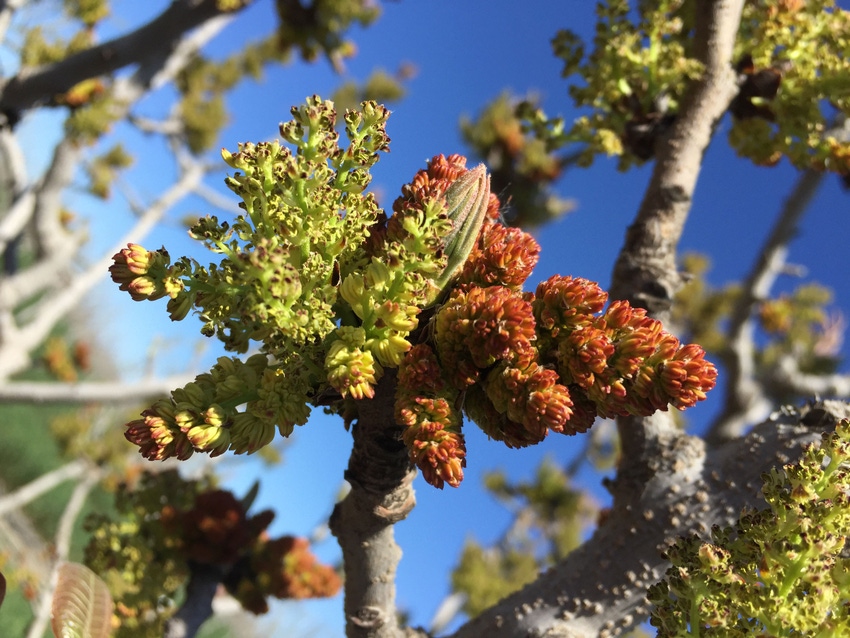June 15, 2016

Most pistachio-growing regions in California received enough chill hours this past winter to facilitate the set of the 2016 crop, says Elizabeth Fichtner, University of California Cooperative Extension (UCCE) farm advisor in Tulare County.
This should come as good news to growers who last year saw their crop drop, due to poor winter chill along with warm and sunny days, and tight water supplies, to its smallest production since 2006 when acreage was half that of 2015.
The average yield of 1,161 pounds per acre was the lowest since 1989.
In an interview, Fichtner offered the disclaimer that one of the models for calculating chill is just that. She said, “It’s a model, not a law of nature,” meaning reaching some magic numbers – or not doing so - is not an assurance of crop size.
Chill accumulation is only one factor contributing to bloom, she said.
Fichtner wrote an article on expected pistachio bloom as an exercise in reviewing chill hour models.
“I’m not a plant physiologist by training,” she said. “It gave me a better understanding of pistachio phenology.”
A key source for her article is a chilling hour calculator on the UC Fruit and Nut Research and Information Center website at www.fruitandnuts.ucdavis.edu. There, growers can see the cumulative chilling hours for the current year plus historical data.
The Peters male pistachio variety requires at least 900 hours below 45 degrees to achieve 50 percent bloom. The Kerman female variety requires 700 hours below 45 degrees to achieve 44 percent bloom.
Among those production areas that fell short of 900 hours this winter were Davis and Coalinga at 796 and 878 respectively, Fichtner said. She said in 1978 “during the infancy of the California pistachio industry” the Davis area had a then-record low accumulation of winter chill at 670 hours.
Last year, Davis experienced only 537 chilling hours.
“The 200 to 300 acres of Kerman pistachios in Yolo County (home to Davis) may fall short of the chill accumulation for pistachios in 2016,” Fichtner said.
On the positive side, she pointed out that Kern County’s Arvin area accumulated 904 chilling hours in 2015-2016. The early winter had 535 chilling hours. In Delano, 983 and 1307 chilling hours were accumulated in 2014-2015 and 2015-2016 respectively.
Other areas which who fell short of the 900 number for 2015-2016 included Kettleman in Kings County at 856 and Tracy in San Joaquin County at 836.
The chill accumulation data is generally derived from CIMIS (California Irrigation Management Information System) stations. Fichtner said there can be gaps in data due to station malfunctions, in some cases resulting from vandalism.
“Because the purpose of CIMIS stations is to provide data for irrigation management, maintenance may be delayed in the winter months when the stations are not utilized for the intended purpose,” she said.
Moreover, she points out, CIMIS stations capture data in specific locations and do not capture the variances of chill accumulation over some regions or in microclimates.
Fichtner credited assistance from other UC researchers including Craig Kallsen, Louise Ferguson, Dan Parfitt, and Katherine Pope for helping her delve into the subject of pistachio bloom and chill hours.
At a Pistachio Day event in Visalia, Ferguson explained that researchers are taking a closer look at the subject of chilling and two models for measurement.
In addition to the 900-hour model that gauges chill between Nov. 1 and Feb. 28, another arrives at “chill portions.” The latter uses a weighted approach for temperatures between 33 and 55 degrees during the same period. With this model, intermittent warm temperatures reverse chill accumulation.
Fichtner said chilling requirements for new female pistachio varieties including Golden Hills and Lost Hills have yet to be assessed, and she would like to study that further. The male pollinator for those two varieties is the Randy variety.
At this year’s Pistachio Day, Kallsen discussed efforts to introduce from the UC breeding program an additional male pollinizer for Kerman, plus a new early-harvesting female and its male pollinizer.
Another Pistachio Day speaker, UC Davis plant scientist Maciej Zwieniecki, said pistachio trees’ use of carbohydrates could have some interplay with chill factors.
He called carbohydrates the trees’ “liquid assets” and characterized soluble carbs as “the cash the tree uses to pay for services. Starches are the savings account the tree draws from when cash is short.”
Zwieniecki said temperatures figure into the balance between starch and sugar.
You May Also Like




